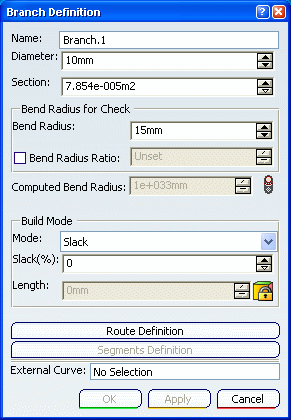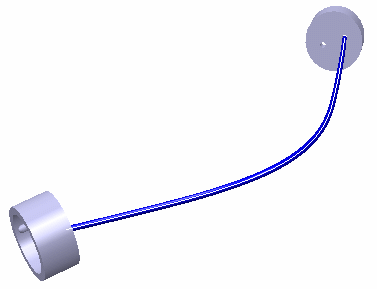Creating an Electrical Branch Geometry and First Branch | |||||||
|
| ||||||
Double-click to activate the electrical geometry.
Click Electrical Branch Geometry
 or select Insert > Electrical Branch Geometry....
or select Insert > Electrical Branch Geometry....A dialog box opens letting you specify product attributes.

The Electrical Branch Geometry is a 3D Part (Part Number, Description, etc. defined in the 3D Part tab), that is to say an object composed of a product with a 3D Representation. Its main characteristic is to have a "Terminal node" behavior and the impossibility to delete the link between the Product and the Representation; the 3D Shape is a mandatory representation.
The electrical branch geometry will then inherit the 3D Part's properties such as deleting, duplicating, versioning, changing maturity.
A 3D Part is also seen as one object in the Propagation and Search in Database dialog boxes.
Enter a name, for example Electrical Branch Geometry, then click Next:
The next part of the dialog lets you manage attributes of the associated representation.
In the next dialog box, click Finish.
The Electrical Assembly Design workbench switches to the Electrical Part Design workbench (representation context).
An electrical branch geometry comprising one branch and one segment is created by default.

The Branch
 command is active and the Branch Definition dialog
box appears:
command is active and the Branch Definition dialog
box appears:
You will now specify segment parameters.
Specify the diameter or the section:
- Enter a value in the Diameter box and have the section computed automatically, Or,
- Enter the Section and have the diameter computed automatically.
In the Bend Radius box, enter the bend radius value.
The bend radius is the minimum bend radius allowed for the whole segment. A bend radius at least equal to the diameter is recommended to avoid tight turns.
- Enter a value in the Bend Radius box, Or,
- Select the Bend Radius Ratio check box then specify a factor, and have the bend radius computed. The factor is multiplied by the diameter to determine the minimum bend radius.
The bend radius entered is used as an input.
In Standard algorithm mode, you can have the system optimize the bend radius to keep the flexible curve.
The Computed bend radius is displayed when you have routed the branch. Status lights show whether or not the computed bend radius respects the minimum bend radius entered.
Select the Build Mode, for example Slack and enter a percentage. Build modes are as follows:
- Slack: Segment length is the minimum length increased by a user-defined percent entered in the Slack(%) box. The Length box is unavailable.
- Length: Segment length is defined by the user in the Length box. The Slack(%) box is unavailable.
- Bend: Segment length corresponds to the minimum computed length between the points defining the segment route. Slack(%) and Length boxes are unavailable.
- Straight bend: Segment length corresponds to the shortest path defined by arcs of circles of fixed radius and straight lines.
At this stage, segment parameters are defined.
You will now route the segment to complete the definition and create the geometrical representation of the flexible curve.
Note: Canceling the branch definition before routing creates a branch set, branch and segment in the specification tree; no geometry, however, is defined.
Click Route Definition and route the branch.
Click OK in the Branch Definition dialog box when done.
The first branch is fully defined with associated geometry and route. The flexible curve is visible in the geometry area.

Important: - Double-click the branch in the specification tree or geometry area to edit it.
- If the branch being edited contains only single route point, the Route definition dialog box will open to allow the re-definition of the branch route. It may happen, for example, after cut and paste of some dependency branches if the lost links are not manually re-created.